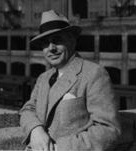Otto Kuhler
US industrial designer born in Remscheid near Essen, Germany, who became one of the best known industrial designers of the American railroads. At age 19 he was commissioned to illustrate a catalog of steam locomotives. His auto body design for a Mercedes chassis won a gold medal in 1913. He served in the German Army in WW I, after which he enrolled in the Academy of Art in Dusseldorf and learned etching. He was employed as a stylist with N.A.G. in Berlin and designed movie sets for the silent film, The Tunnel. He became associate editor of Der Motor magazine, and then styled car bodies for Snutsel Pére & Fils in Brussels and other European auto producers including a 1914 roadster for Fiat.
Kuhler emigrated to US in 1923 and worked as a commercial artist in Pittsburgh. He became a citizen in 1928, and opened a studio in Manhattan that year, promoting streamlining of railroad equipment. He worked for J.G. Brill & Company styling trains and trolleys. He designed a smooth front-end trolley called the Brill Bullet in 1931. In 1931 the American Locomotive Company (ALCO) assigned him to its advertising department, and commissioned him as a design consultant in 1932. When ALCO built four Hiawatha locomotives in 1934 for the Milwaukee Road, Kuhler designed their exterior, including their streamlined steam locomotive, their famous “beaver-tail” observation cars and all their interiors down to the napkins and draperies.
He worked with the Baltimore & Ohio (B&O) Railroad as art director of the B&O magazine, and developed B&O’s logo. When B&O turned to streamlining, he designed a bullet-nosed steam locomotive, known as the “Kuhler type,” on B&O’s Royal Blue train on the Washington-New York run, which Raymond Loewy, FIDSA emulated in his S-1 engine for the 1939 Worlds Fair. For B&O, Kuhler also designed buses made by White Motor Company to transport passengers to Manhattan from New Jersey. Kuhler streamlined more locomotives and railroad cars than Loewy, Paul Cret and Henry Dreyfuss, FIDSA combined.
After WW II began, his German accent became a liability in business, and he abandoned free-lance work. In 1944 he worked for American Car and Foundry where he developed double deck sleepers and subway cars, but was laid off in 1947. He retired to a ranch near Pine, CO where he painted the West, exhibited in museums and raised cattle. In 1969 he relocated to Santa Fe, NM, and again in 1976 to Denver, CO, where he died.

